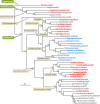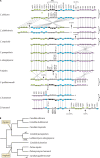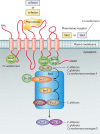Fungal sex and pathogenesis
- PMID: 20065328
- PMCID: PMC2806657
- DOI: 10.1128/CMR.00053-09
Fungal sex and pathogenesis
Abstract
Human fungal pathogens are associated with diseases ranging from dandruff and skin colonization to invasive bloodstream infections. The major human pathogens belong to the Candida, Aspergillus, and Cryptococcus clades, and infections have high and increasing morbidity and mortality. Many human fungal pathogens were originally assumed to be asexual. However, recent advances in genome sequencing, which revealed that many species have retained the genes required for the sexual machinery, have dramatically influenced our understanding of the biology of these organisms. Predictions of a rare or cryptic sexual cycle have been supported experimentally for some species. Here, I examine the evidence that human pathogens reproduce sexually. The evolution of the mating-type locus in ascomycetes (including Candida and Aspergillus species) and basidiomycetes (Malassezia and Cryptococcus) is discussed. I provide an overview of how sex is suppressed in different species and discuss the potential associations with pathogenesis.
Figures





References
Publication types
MeSH terms
LinkOut - more resources
Full Text Sources
Medical

